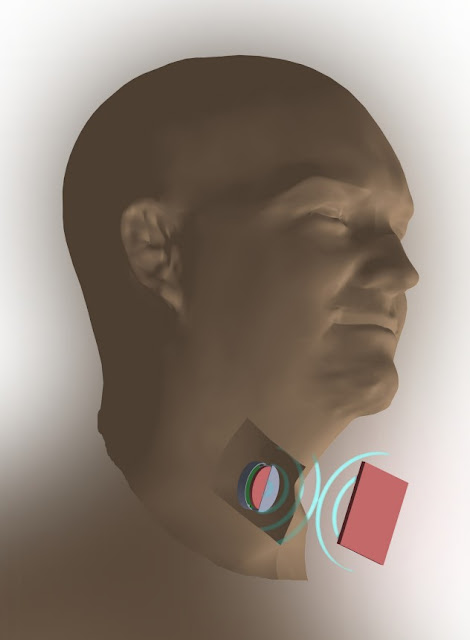Credit; © Photo Fraunhofer IBMT
Treatment for high blood pressure, diabetes or Parkinson’s
The demonstrator, designed as a universal technology platform, can be adapted for various applications and model variants. It can be powered with or without a battery and can be configured for a wide range of applications for active implants. One example is the treatment of common diseases such as high blood pressure, diabetes and Parkinson’s disease. The research team developed a complete system that includes the transmitter outside the body and the receiver in the implant. The demonstrator also falls well below stipulated regulatory limits for ultrasound treatments on the human body.
“We’re seeking industry partners at the trade fair to develop our technology platform into a concrete product. The technology could be developed within a year,” says Andreas Schneider, manager of the Active Implants working group at IBMT. In May 2016, market research company BBC Research valued the market for microelectronic medical implants at 24.6 billion US dollars and predicted that this figure would grow to 37.6 billion US dollars by 2021, assuming an average annual growth rate of 8.8 percent.
Ultrasound waves are mechanical waves, emitted and absorbed by piezoelectric material in transmitters and receivers. The piezoelectric transducers change shape imperceptibly when a voltage is applied. This deformation releases mechanical waves, similar to sound waves from a loudspeaker, which then strike the piezoelectric receiver. The waves also cause the receiver to change shape, but with the difference that exactly the opposite reaction occurs: the deformation produces an electrical current.
An alternative to drugs
Active implants are able to support certain bodily functions in people with illnesses, and to compensate for dysfunctions. Usually inserted just under the skin, they can control heart rhythm (pacemakers), support sensory perception (retinal and cochlear implants) and control artificial limbs (prosthetic hands). Measuring just a few centimeters, these small medical devices also handle some other major tasks, such as dosing drugs and supporting bone growth. “Our bodies work by means of electrical signals. Active implants model this functionality,” Schneider explains.
Peter-Karl Weber from the main department Ultrasound at Fraunhofer IBMT adds: “Some improvements can be achieved with drugs, but the disadvantage is that they act indirectly and affect the entire body. Active implants act directly and locally where they are needed.” The scientists hope to see widespread diseases such as high blood pressure and diabetes treated this way in the near future. “To achieve this, we will need more powerful, miniaturized, yet robust technologies. We have shown that ultrasound is a new way forward for powering active implants,” says Weber.
The basic structure of active implants has barely changed in recent years. Just like the first commercial pacemakers, they are composed of electronic components that are hermetically encapsulated in a titanium casing. Electrical feedthroughs in the titanium casing and cable connections conduct electrical impulses directly to electrodes in the cardiac muscle. The basic problem remains the power supply. Batteries have the disadvantage that they take up a lot of space – often half of the implant – and need to be changed regularly in a surgical procedure.
Induction, which functions through electromagnetic wave transfer of energy and information, became an established wireless alternative for implants: two coils convert electricity into magnetic fields and then back again. The drawback here is that the electromagnetic waves are shielded by the metallic implant casing, “similar to the concept of lightning striking a Faraday cage,” explains Schneider. For this reason, the coils must be placed outside the casing. “With our technology, the ultrasound receiver is inside the hermetic casing, directly on the casing wall. The implant wall and the receiver form a single system that permits ultrasound waves to be received and emitted,” says Schneider.



